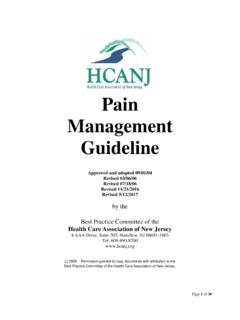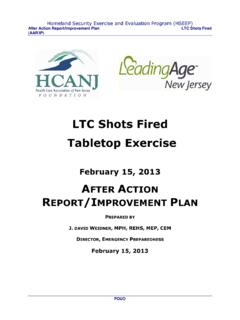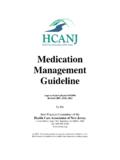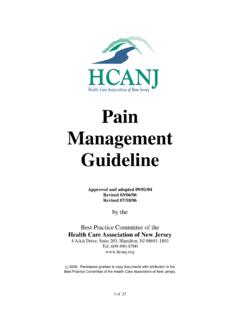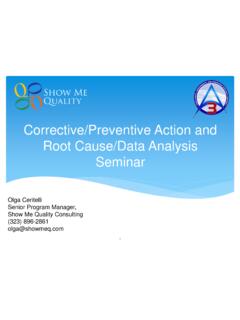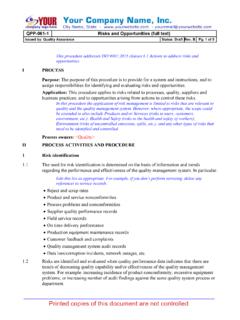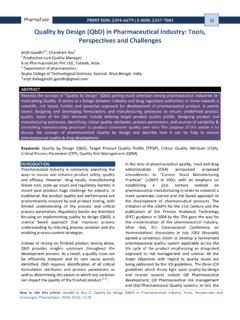Transcription of Performance Improvement (PI) Plan and Template
1 Performance Improvement (PI) plan and Template Approved and adopted 11/2009 by the Best Practices Committee of the Health Care Association of New Jersey 4 AAA Drive, Suite 203, Hamilton, NJ 08691 Tel: 609-890-8700 2009. Permission granted to copy documents with attribution to the Best Practices Committee of the Health Care Association of New Jersey. HCANJ Best Practices Committee Performance Improvement (PI) plan and Template Table of Contents Page Disclaimer i. Introduction to the Performance Improvement (PI) plan and Template A. General Introduction B. How to Use the Template ii. - iii. I. Introduction to Performance Improvement A. Mission Statement B. Vision Statement C. Statement of Values D. Fundamentals of Performance Improvement 1.
2 - 2. II. Objectives of the Performance Improvement plan 2. III. Performance Improvement plan Participants and Respective Responsibilities A. Board of Directors/Governing Authority B. Facility Leaders C. Performance Improvement Committee D. Facility Staff E. Residents and Families F. Consultants G. Vendors and Product/Services Suppliers H. Community Representatives 2. - 3. IV. Identifying Potential Areas for Improvement A. Clinical Care/Services Opportunities B. Non-Clinical Care Opportunities C. Government, Accreditation and Professional Requirements D. HCANJ Best Practices 3. 40. V. Prioritize Opportunities to Improve A . Staff and Consumer Participants B. Selecting Best Opportunities to Improve 3. - 4. VI. Sources and Collection of Data that Yields Useful Information A.
3 What to Monitor B. Sampling: What and How to Sample 4. - 7. VII. analysis of Data and Information A. P I Process Cycle B. Root cause analysis (RCA) C. Benchmarking D. Presenting Data and Information to Various Stakeholders 7. - 9. VIII. Confidentiality of Data, Information, Findings and Reports . IX. Education/Training A. Senior Management B. P I Committee Members and Participants C. All Staff D. Residents and Families E. Community Members and Others 9. - 10. X. Appendix A: Definitions B: Exhibits, Forms and Tools 1. Design, Measure, Assess, Improve, and Control (DMAIC) Tool 2. plan , Do, Check, Act (PDCA) Tool 3. Fishbone Diagram 4. Root Cause analysis (RCA) 5. Cause and effect Map 6. failure Mode and effects analysis (FMEA) 7.
4 SMART Tool 8. Pareto analysis Chart (PAC) 10. 10. - 17. 17. 18. - 20. 21. - 24. 25. - 26. 27. - 32. 33. - 34. 35. 36. 37. - 38. XI. Bibliography, Reference Citing and Internet Sites of Interest 39. - 40. HCANJ Best Practices Committee Performance Improvement (PI) plan and Template Best Practice Guideline DISCLAIMER: This Best Practice Guideline is presented as a model only by way of illustration. It has not been reviewed by counsel. Before applying a particular form to a specific use by your organization, it should be reviewed by counsel knowledgeable concerning applicable federal and state health care laws and rules and regulations. This Best Practice Guideline should not be used or relied upon in any way without consultation with and supervision by qualified physicians and other healthcare professionals who have full knowledge of each particular resident s case history and medical condition.
5 This Best Practice Guideline is offered to nursing facilities, assisted living facilities, residential health care facilities, adult day health services providers and other professionals for informational and educational purposes only. The Health Care Association of New Jersey (HCANJ), its executers, administrators, successors, and members hereby disclaim any and all liability for damage of whatever kind resulting from the use, negligent or otherwise, of this Best Practice Guideline herein. This Best Practice Guideline was developed by the HCANJ Best Practice Committee ( Committee ), a group of volunteer professionals actively working in or on behalf of health care facilities in New Jersey, including skilled nursing facilities, sub-acute care and assisted living providers.
6 The Committee s development process included a review of government regulations, literature review , expert opinions, and consensus. The Committee strives to develop guidelines that are consistent with these principles: Relative simplicity Ease of implementation Evidence-based criteria Inclusion of suggested, appropriate forms Application to various long term care settings Consistent with statutory and regulatory requirements Utilization of state and federal government terminology, definitions and data collection Appropriate staff at each facility/program should develop specific policies, procedures and protocols to best assure the efficient, implementation of the Best Practice Guideline s principles. The Best Practice Guidelines usually assume that recovery/rehabilitation is the treatment or care plan goal.
7 Sometimes, other goals may be appropriate. For example, for patients receiving palliative care, promotion of comfort (pain control) and dignity may take precedence over other guideline objectives. Guidelines may need modification to best address each facility, patient and family s expectations and preferences. Recognizing the importance of implementation of appropriate guidelines, the Committee plans to offer education and training. The HCANJ Best Practice Guidelines will be made available at 2009. Permission granted to copy documents with attribution to the Best Practices Committee of the Health Care Association of New Jersey. i. HCANJ Best Practices Committee Performance Improvement (PI) plan and Template Best Practice Guideline INTRODUCTION TO THE Performance Improvement (PI) plan AND Template A.
8 GENERAL INTRODUCTION This Performance Improvement Best Practice plan and Template was developed by the Health Care Association of New Jersey s (HCANJ) Best Practices Committee, an all volunteer team of practicing long term care professionals. The plan and Template development process included a review of government regulations, relevant literature, various Performance Improvement programs, expert opinions and consensus. This Performance Improvement (PI) plan guideline is in the form of a Template . The Template s design is relatively easy to use and customize. Current, evidence-based criteria for defining, advancing and sustaining Performance Improvement strategies have been incorporated into the document, as well as suggested forms and analytical tools.
9 The Template may be used in various long term care settings, such as, nursing and skilled nursing facilities, sub-acute care facilities, assisted living facilities and programs, residential care settings and in adult medical day health care services. Organizations may use this PI plan Template in several ways: 1. Those with well established, effective PI plans may wish to review this Template and select components to incorporate into their pre-existing plan . 2. Those with reasonably complete and effective plans may wish to use this Template as the foundation for their new plan by incorporating selective elements of their pre-existing plan into this Template . 3. Those with no well-established, successful PI plans may elect to use this Template to formalize their new PI plan .
10 The Best Practices Committee of HCANJ recommends that organizations that intend to use this Template as the foundation for their new or updated PI plan proceed as follows. Designate a team of knowledgeable senior leaders, day-to-day managers, key clinical care and service directors/supervisors, front line staff, consumers, community leaders and consultants to carefully review this plan Template and make thoughtful, appropriate, adjustments in the Template to produce a draft comprehensive, organization- specific PI plan . Then, senior management should review the draft plan , make appropriate adjustments as needed, and approve the plan . The Best Practices Committee suggests that each facility/program conduct a formal review and revision (as needed) of its PI plan at regular intervals, not to exceed every twelve (12) months.
